Chester W. Nimitz
| Chester W. Nimitz | |
|---|---|
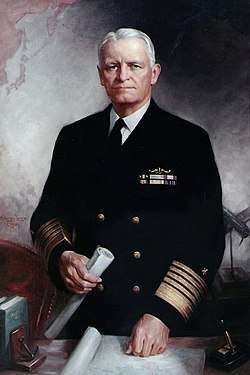 Portrait of Fleet Admiral Chester W. Nimitz | |
| Born |
February 24, 1885 Fredericksburg, Texas, U.S. |
| Died |
February 20, 1966 (aged 80) Yerba Buena Island, California, U.S. |
| Buried |
Golden Gate National Cemetery San Bruno, California, U.S. |
| Allegiance | United States |
| Service/ | United States Navy |
| Years of service | 1905–1966[1] |
| Rank | Fleet Admiral |
| Service number | 5572 |
| Commands held |
Chief of Naval Operations Pacific Ocean Areas United States Pacific Fleet Bureau of Navigation USS Augusta (CA-31) USS Rigel (AR-11) USS Chicago (CA-14) Atlantic Submarine Flotilla USS Skipjack (SS-24) 3rd Submarine Division Atlantic Torpedo Fleet USS Narwhal (SS-17) USS Snapper (SS-16) USS Plunger (SS-2) First Submarine Flotilla USS Decatur (DD-5) |
| Battles/wars | |
| Awards |
Navy Distinguished Service Medal (4) Army Distinguished Service Medal Silver Lifesaving Medal Full list |
| Relations |
Charles Henry Nimitz (grandfather) Chester Nimitz Jr. (son) |
| Other work | Regent of the University of California |
| Signature |
|
Chester William Nimitz, Sr. (/ˈnɪmɪts/; February 24, 1885 – February 20, 1966) was a fleet admiral of the United States Navy. He played a major role in the naval history of World War II as Commander in Chief, U.S. Pacific Fleet and Commander in Chief, Pacific Ocean Areas, commanding Allied air, land, and sea forces during World War II.[2]
Nimitz was the leading US Navy authority on submarines. Qualified in submarines during his early years, he later oversaw the conversion of these vessels' propulsion from gasoline to diesel, and then later was key in acquiring approval to build the world's first nuclear-powered submarine, USS Nautilus, whose propulsion system later completely superseded diesel-powered submarines in the US. He also, beginning in 1917, was the Navy's leading developer of underway replenishment techniques, the tool which during the Pacific war would allow the US fleet to operate away from port almost indefinitely. The chief of the Navy's Bureau of Navigation in 1939, Nimitz served as Chief of Naval Operations from 1945 until 1947. He was the United States' last surviving officer who served in the rank of fleet admiral.
Early life and education
Nimitz, a German Texan, was born the son of Anna Josephine (Henke) and Chester Bernhard Nimitz on February 24, 1885, in Fredericksburg, Texas,[3] where his grandfather's hotel is now the Admiral Nimitz State Historic Site. His frail, rheumatic father had died six months earlier, on August 14, 1884.[4] He was significantly influenced by his German-born paternal grandfather, Charles Henry Nimitz, a former seaman in the German Merchant Marine, who taught him, "the sea – like life itself – is a stern taskmaster. The best way to get along with either is to learn all you can, then do your best and don't worry – especially about things over which you have no control."[5] His grandfather became a Texas Ranger in the Texas Mounted Volunteers in 1851. He then served as captain of the Gillespie Rifles Company in the Confederate States Army during the Civil War.[6]
Originally, Nimitz applied to West Point in hopes of becoming an Army officer, but no appointments were available. His congressman, James L. Slayden, told him that he had one appointment available for the United States Naval Academy and that he would award it to the best qualified candidate. Nimitz felt that this was his only opportunity for further education and spent extra time studying to earn the appointment. He was appointed to the Naval Academy from Texas's 12th congressional district in 1901, and he graduated with distinction on January 30, 1905, seventh in a class of 114.[7]
Military career
Early career

.jpg)
Nimitz joined the battleship Ohio at San Francisco, and cruised on her to the Far East. In September 1906, he was transferred to the cruiser Baltimore; on January 31, 1907, after the two years at sea as a warrant officer then required by law, he was commissioned as an ensign. Remaining on Asiatic Station in 1907, he successively served on the gunboat Panay, destroyer Decatur, and cruiser Denver.
The destroyer Decatur ran aground on a mud bank in the Philippines on July 7, 1908 while under the command of Ensign Nimitz. The ship was pulled free the next day, and Nimitz was court-martialed, found guilty of neglect of duty, and issued a letter of reprimand.[8]
Nimitz returned to the United States on board USS Ranger when that vessel was converted to a school ship, and in January 1909, began instruction in the First Submarine Flotilla. In May of that year, he was given command of the flotilla, with additional duty in command of USS Plunger, later renamed A-1. He commanded USS Snapper (later renamed C-5) when that submarine was commissioned on February 2, 1910, and on November 18, 1910 assumed command of USS Narwhal (later renamed D-1).[8]
In the latter command, he had additional duty from October 10, 1911 as Commander 3rd Submarine Division Atlantic Torpedo Fleet. In November 1911, he was ordered to the Boston Navy Yard, to assist in fitting out USS Skipjack and assumed command of that submarine, which had been renamed E-1, at her commissioning on February 14, 1912. On the monitor Tonopah (then employed as a submarine tender) on March 20, 1912, he rescued Fireman Second Class W. J. Walsh from drowning, receiving a Silver Lifesaving Medal for his action.[8]
After commanding the Atlantic Submarine Flotilla from May 1912 to March 1913, he supervised the building of diesel engines for the fleet oil tanker Maumee, under construction at the New London Ship and Engine Company, Groton, Connecticut.[9]
World War I
In the summer of 1913, Nimitz (who spoke German) studied engines at the diesel engine plants in Nuremberg, Germany, and Ghent, Belgium. Returning to the New York Navy Yard, he became executive and engineer officer of Maumee at her commissioning on October 23, 1916.
After the United States declared war on Germany in April 1917, Nimitz was Chief Engineer of Maumee while the vessel served as a refueling ship for the first squadron of U.S. Navy destroyers to cross the Atlantic, to take part in the war. Under his supervision, Maumee conducted the first-ever underway refuelings. On August 10, 1917, Nimitz became aide to Rear Admiral Samuel S. Robison, Commander, Submarine Force, U.S. Atlantic Fleet (COMSUBLANT).
On February 6, 1918, Nimitz was appointed chief of staff and was awarded a Letter of Commendation for meritorious service as COMSUBLANT's chief of staff. On September 16, he reported to the office of the Chief of Naval Operations, and on October 25 was given additional duty as Senior Member, Board of Submarine Design.
Between the wars
From May 1919 to June 1920, Nimitz served as executive officer of the battleship South Carolina. He then commanded the cruiser Chicago with additional duty in command of Submarine Division 14, based at Pearl Harbor, Hawaii. Returning to the mainland in the summer of 1922, he studied at the Naval War College, Newport, Rhode Island.
In June 1923, he became aide and assistant chief of staff to the Commander, Battle Fleet, and later to the Commander In Chief, United States Fleet. In August 1926, he went to the University of California, Berkeley, to establish the Navy's first Naval Reserve Officer Training Corps unit.
Nimitz lost part of one finger in an accident with a diesel engine, only saving the rest of it when the machine jammed against his Annapolis ring.[10]
In June 1929, he took command of Submarine Division 20. In June 1931, he assumed command of the destroyer tender Rigel and the destroyers out of commission at San Diego, California. In October 1933, he took command of the cruiser Augusta and deployed to the Far East, where in December, Augusta became the flagship of the Asiatic Fleet.
In April 1935, Nimitz returned home for three years as assistant chief of the Bureau of Navigation, before becoming commander, Cruiser Division 2, Battle Force. In September 1938. he took command of Battleship Division 1, Battle Force. On June 15, 1939, he was appointed chief of the Bureau of Navigation. During this time, Nimitz conducted experiments in the underway refueling of large ships which would prove a key element in the Navy's success in the war to come.
World War II
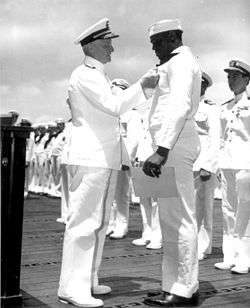
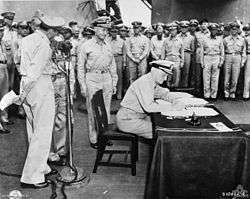
Ten days after the attack on Pearl Harbor on December 7, 1941, Nimitz was selected by President Franklin D. Roosevelt to be commander-in-chief, United States Pacific Fleet (CINCPACFLT). He was promoted to the rank of admiral, effective December 31, 1941. Nimitz immediately departed Washington for Hawaii and took command in a ceremony on the top deck of the submarine Grayling. The change of command ceremony would normally have taken place aboard a battleship, but every battleship in Pearl Harbor had been either sunk or damaged during the attack. Assuming command at the most critical period of the war in the Pacific, Admiral Nimitz successfully organized his forces to halt the Japanese advance despite the losses from the attack on Pearl Harbor and the shortage of ships, planes, and supplies.
On March 24, 1942, the newly formed US-British Combined Chiefs of Staff issued a directive designating the Pacific theater an area of American strategic responsibility. Six days later, the US Joint Chiefs of Staff (JCS) divided the theater into three areas: the Pacific Ocean Areas, the Southwest Pacific Area (commanded by General Douglas MacArthur), and the Southeast Pacific Area. The JCS designated Nimitz as "Commander in Chief, Pacific Ocean Areas", with operational control over all Allied units (air, land, and sea) in that area.
Nimitz faced superior Japanese forces at the crucial defensive actions of the Battle of the Coral Sea and the Battle of Midway. The Battle of the Coral Sea, while a loss in terms of total damage suffered, resulted in the strategic success of turning back a Japanese invasion of Port Moresby on the island of Papua–New Guinea. Two Japanese carriers were temporarily taken out of action in the battle, which would deprive the Japanese of their use in the Midway operation that shortly followed. The severe losses in Japanese carriers at Midway affected the balance of naval air power during the remainder of 1942, and was crucial in neutralizing Japanese offensive threats in the South Pacific. Naval engagements during the Battle of Guadalcanal left both forces severely depleted. However, with the allied advantage in land-based air power, the results were sufficient to secure Guadalcanal. The US and allied forces then undertook to neutralize remaining Japanese offensive threats with the Solomon Islands campaign and the New Guinea Campaign, while building capabilities for major fleet actions. In 1943, Midway became a forward submarine base, greatly enhancing US capabilities against Japanese shipping.
Through 1943, Nimitz gained the materiel and manpower needed to launch major fleet offensives to destroy Japanese power in the central Pacific region. This drive opened with the Gilbert and Marshall Islands campaign from November 1943 to February 1944, followed by the destruction of the strategic Japanese base at Truk Lagoon, and the Marianas campaign that brought the Japanese homeland within range of new strategic bombers. Nimitz's forces inflicted a decisive defeat on the Japanese fleet in the Battle of the Philippine Sea (June 19–20, 1944), which allowed the capture of Saipan, Guam, and Tinian. His Fleet Forces isolated enemy-held bastions on the central and eastern Caroline Islands and secured in quick succession Peleliu, Angaur, and Ulithi. In the Philippines, his ships destroyed much of the remaining Japanese naval power at the Battle of Leyte Gulf, October 24 to 26, 1944. With the loss of the Philippines, Japan's energy supply routes from Indonesia came under direct threat, crippling their war effort.
By Act of Congress, passed on December 14, 1944, the rank of fleet admiral — the highest rank in the Navy — was established. The next day President Franklin Roosevelt appointed Nimitz to that rank. Nimitz took the oath of that office on December 19, 1944.
In January 1945, Nimitz moved the headquarters of the Pacific Fleet forward from Pearl Harbor to Guam for the remainder of the war. Nimitz's wife remained in the continental United States for the duration of the war, and did not join her husband in Hawaii or Guam.
In 1945, Nimitz's forces supported successful amphibious assaults on Iwo Jima and Okinawa, and launched raids against the home waters of Japan. In addition, Nimitz also ordered the United States Army Air Forces to mine the Japanese ports and waterways by air with B-29 Superfortresses in a successful mission called Operation Starvation, which severely interrupted the Japanese logistics.
On September 2, 1945, Nimitz signed as representative of the United States when Japan formally surrendered on board USS Missouri in Tokyo Bay. On October 5, 1945, which had been officially designated as "Nimitz Day" in Washington, D.C., Nimitz was personally presented a second Gold Star for the third award of the Navy Distinguished Service Medal by President Harry S. Truman "for exceptionally meritorious service as Commander in Chief, U.S. Pacific Fleet and Pacific Ocean Areas, from June 1944 to August 1945."
Post war
On November 26, 1945, Nimitz's nomination as Chief of Naval Operations (CNO) was confirmed by the U.S. Senate, and on December 15, 1945, he relieved Fleet Admiral Ernest J. King. He had assured the President that he was willing to serve as the CNO for one two-year term, but no longer. He tackled the difficult task of reducing the most powerful navy in the world to a fraction of its war-time strength, while establishing and overseeing active and reserve fleets with the strength and readiness required to support national policy.
For the postwar trial of German Grand Admiral Karl Dönitz at the Nuremberg Trials in 1946, Nimitz furnished an affidavit in support of the practice of unrestricted submarine warfare, a practice that he himself had employed throughout the war in the Pacific. This evidence is widely credited as a reason why Dönitz was sentenced to only 10 years of imprisonment.[11]
Nimitz endorsed an entirely new course for the U.S. Navy's future by way of supporting then-Captain Hyman G. Rickover's chain-of-command-circumventing proposal in 1947 to build USS Nautilus, the world's first nuclear-powered vessel.[12] As is noted at a display at the Nimitz Museum in Fredericksburg, Texas: "Nimitz's greatest legacy as CNO is arguably his support of Admiral Hyman Rickover's effort to convert the submarine fleet from diesel to nuclear propulsion."
From 1949 to 1953, Nimitz served as UN-appointed Plebiscite Administrator for Jammu and Kashmir.[13] His proposed role as administrator was accepted by Pakistan but rejected by India.[14][15]
Inactive duty as a fleet admiral
Nimitz retired from office as CNO on December 15, 1947 and received a third Gold Star in lieu of a fourth Navy Distinguished Service Medal. However, since the rank of fleet admiral is a lifetime appointment, he remained on active duty for the rest of his life, with full pay and benefits. He and his wife, Catherine, moved to Berkeley, California. After he suffered a serious fall in 1964, he and Catherine moved to US Naval quarters on Yerba Buena Island in the San Francisco Bay.
In San Francisco, Nimitz served in the mostly ceremonial post as a special assistant to the Secretary of the Navy in the Western Sea Frontier. He worked to help restore goodwill with Japan after World War II by helping to raise funds for the restoration of the Japanese Imperial Navy battleship Mikasa, Admiral Heihachiro Togo's flagship at the Battle of Tsushima in 1905.
Nimitz was also appointed as the United Nations Plebiscite Administrator for Kashmir on 31 December 1948. The terms of the plebiscite were that Pakistan would vacate regions of Kashmir under its control, and that India would remove additional military from kashmir. But due to disagreements between the two regarding demilitarisation, the plebiscite is still pending.[16]
Nimitz became a member of the Bohemian Club of San Francisco. In 1948, he sponsored a Bohemian dinner in honor of U.S. Army General Mark Clark, known for his campaigns in North Africa and Italy.[17]
Nimitz served as a regent of the University of California during 1948–1956, where he had formerly been a faculty member as a professor of naval science for the Naval Reserve Officer Training Corps program. Nimitz was honored on October 17, 1964, by the University of California on Nimitz Day.
Personal life
Nimitz married Catherine Vance Freeman (March 22, 1892 – February 1, 1979) on April 9, 1913, in Wollaston, Massachusetts.[8] Nimitz and his wife had four children:
- Catherine Vance "Kate" (22 February 1914, Brooklyn, NY – 14 January 2015)[18][19]
- Chester William "Chet", Jr. (1915–2002[18][20])
- Anna Elizabeth "Nancy" (1919–2003[21][22])
- Mary Manson (1931–2006[23][24])
Catherine Vance graduated from the University of California, Berkeley, in 1934,[25] became a music librarian with the Washington D.C. Public Library,[26] and married U.S. Navy Commander James Thomas Lay (1909–2001[27]), from St. Clair, Missouri, in Chester and Catherine's suite at the Fairfax Hotel in Washington, D.C., on March 9, 1945.[28] She had met Lay in the summer of 1934 while visiting her parents in Southeast Asia.[25]
Chester Nimitz, Jr., graduated from the U.S. Naval Academy in 1936 and served as a submariner in the Navy until his retirement in 1957, reaching the (post retirement) rank of rear admiral; he served as chairman of PerkinElmer from 1969–1980.
Anna Elizabeth ("Nancy") Nimitz was an expert on the Soviet economy at the RAND Corporation from 1952 until her retirement in the 1980s.
Sister Mary Aquinas (Nimitz) became a sister in the Order of Preachers (Dominicans), working at the Dominican University of California. She taught biology for 16 years, and was academic dean for 11 years, acting president for one year, and vice president for institutional research for 13 years before becoming the university's emergency preparedness coordinator. She held this job until her death, due to cancer, on February 27, 2006.
Death
In late 1965, Nimitz suffered a stroke, complicated by pneumonia. In January 1966, he left the U.S. Naval Hospital (Oak Knoll) in Oakland to return home to his naval quarters. He died at home at age 80 on the evening of February 20 at Quarters One on Yerba Buena Island in San Francisco Bay.[29] His funeral on February 24 was at the chapel of adjacent Naval Station Treasure Island and Nimitz was buried with full military honors at Golden Gate National Cemetery in San Bruno.[30][31][32][33][34] He lies alongside his wife and his long-term friends Admiral Raymond A. Spruance, Admiral Richmond K. Turner, and Admiral Charles A. Lockwood and their wives, an arrangement made by all of them while living.[35]
Dates of rank
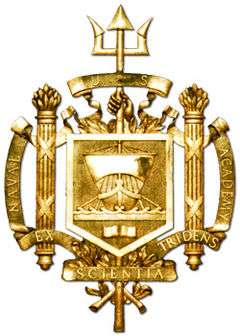
| Ensign | Lieutenant junior grade | Lieutenant | Lieutenant commander | Commander | Captain |
|---|---|---|---|---|---|
| O-1 | O-2 | O-3 | O-4 | O-5 | O-6 |
 |
 |
 |
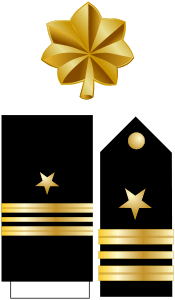 |
 |
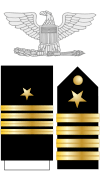 |
| January 7, 1907 | Never held | January 31, 1910 | August 29, 1916 | February 1, 1918 | June 2, 1927 |
| Commodore | Rear admiral | Vice admiral | Admiral | Fleet admiral |
|---|---|---|---|---|
| O-7 | O-8 | O-9 | O-10 | O-11 |
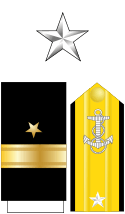 |
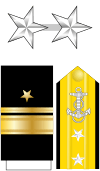 |
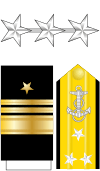 |
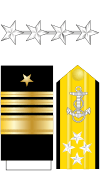 |
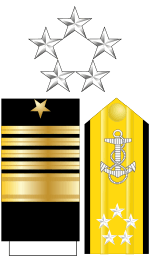 |
| Never held | June 23, 1938 | Never held | December 31, 1941 | December 19, 1944 |
- Commodore – no longer a rank in the United States Navy, was previously reserved for wartime use and was not in use at the time of Nimitz's promotion to flag rank. Currently, a captain who is promoted to pay grade O-7 becomes a rear admiral (lower half) and uses the abbreviated rank designation RDML as opposed to RADM, which designates a rear admiral (upper half), O-8. During Admiral Nimitz's service, the only rank existing among these was rear admiral, without distinction between upper and lower half.
- Fleet admiral – rank made permanent in the United States Navy on May 13, 1946, a lifetime appointment.
At the time of Nimitz's promotion to rear admiral, the United States Navy did not maintain a one-star rank (Commodore). Nimitz was thus promoted directly from a captain to rear admiral. By Congressional appointment, he skipped the rank of vice admiral and became an admiral in December 1941.
Nimitz also never held the rank of lieutenant junior grade, as he was appointed a full lieutenant after three years of service as an ensign. For administrative reasons, Nimitz's naval record states that he was promoted to the rank of lieutenant junior grade and lieutenant on the same day.[36]
Decorations and awards
United States awards
Foreign awards
Orders
| United Kingdom – Knight Grand Cross of the Order of the Bath | |
| France – Grand-Officier de la Légion d'honneur | |
| Netherlands – Order of Orange-Nassau with Swords in the Degree of the Knight Grand Cross (Dutch: Ridder Grootkruis in de Orde van Oranje Nassau) | |
| Greece – Grand Cross of the Order of George I | |
| China – Grand Cordon of Pao Ting (Tripod) Special Class | |
| Guatemala – Cross of Military Merit First Class (Spanish: La Cruz de Merito Militar de Primera Clase) | |
| Cuba – Grand Cross of the Order of Carlos Manuel de Cespedes | |
| Argentina – Order of the Liberator General San Martín (Spanish: Orden del Libertador San Martin) | |
| Ecuador – Order of Abdon Calderon (1st Class) | |
| Belgium – Grand Cross Order of the Crown (Belgium) with Palm (French: Grand Croix de l'ordre de la Couronne avec palme) | |
| Italy – Knight of the Grand Cross of the Military Order of Italy (Cavaliere di Gran Croce) | |
| Brazil – Order of Naval Merit (Ordem do Mérito Naval) |
Decorations
| Philippines – Philippine Medal of Valor | |
| Belgium – War Cross with Palm (French: Croix de Guerre Avec Palme) |
Service medals
| United Kingdom – Pacific Star | |
| Philippines – Liberation Medal with one bronze service star |
Memorials and legacy
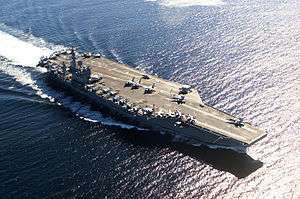
Besides the honor of a United States Great Americans series 50¢ postage stamp, the following institutions and locations have been named in honor of Nimitz:
- USS Nimitz, the first of her class of ten nuclear-powered supercarriers, which was commissioned in 1975 and remains in service
- Nimitz Foundation, established in 1970, which funds the National Museum of the Pacific War and the Admiral Nimitz Museum, Fredericksburg, Texas
- The Nimitz Freeway (Interstate 880) – from Oakland to San Jose, California, in the San Francisco Bay Area
- Nimitz Glacier in Antarctica for his service during Operation Highjump as the CNO
- Nimitz Boulevard – a major thoroughfare in the Point Loma Neighborhood of San Diego
- Camp Nimitz, a recruit camp constructed in 1955 at the Naval Training Center, San Diego
- Nimitz Highway – Hawaii Route 92 located in Honolulu, Hawaii near the Daniel K. Inouye International Airport
- The Nimitz Library, the main library at the U.S. Naval Academy, Annapolis, Maryland
- Nimitz Drive, in the Admiral Heights neighborhood of Annapolis, Maryland
- Callaghan Hall (the Naval and Air Force ROTC building at UC Berkeley) containing the Nimitz Library (was gutted by arson in 1985)
- The town of Nimitz in Summers County, West Virginia
- The summit on Guam where Chester Nimitz relocated his Pacific Fleet headquarters, and where the current Commander U.S. Naval Forces Marianas (ComNavMar) resides, is called Nimitz Hill
- Nimitz Park, a recreational area located at United States Fleet Activities Sasebo, Japan
- The Nimitz Trail in Tilden Park in Berkeley, California
- The Main Gate at Pearl Harbor is called Nimitz Gate
- Admiral Nimitz Circle – located in Fair Park, Dallas, Texas
- Chester Nimitz Oriental Garden Waltz performed by Austin Lounge Lizards
- Admiral Nimitz Fanfare composed by John Steven Lasher (2014)
- Admiral Nimitz March composed by John Steven Lasher (2014)
- The Nimitz Building, Raytheon Company site headquarters, Portsmouth, Rhode Island
- Nimitz Road in Diego Garcia, British Indian Ocean Territory is named in his honor.
- Nimitz Place part of Havemeyer Park located in Old Greenwich, Connecticut was named in his honor along with many other World War II military personnel.
- Nimitz Hall is the Officer Candidate School barracks of Naval Station Newport, Newport, Rhode Island. The barracks was dedicated March 15, 2013.
- Nimitz-McArthur Building, Headquarters U.S. Pacific Command
- Nimitz Statue, designed by Armando Hinojosa of Laredo, is located at the entrance to SeaWorld in San Antonio, Texas.
- Fleet Admiral Chester W. Nimitz Statue, commissioned by the Naval Order of the United States, is situated near the bow of the USS Missouri memorial on Ford Island, facing the USS Arizona memorial. The statue was dedicated September 2, 2013.[37]
- Nimitz Beach Park, Agat, Guam
- Nimitz Drive, Purdue University, West Lafayette, Indiana
Schools
- Nimitz High School, (Harris County, Texas)
- Nimitz High School, Irving, Texas
- Nimitz Junior High School, Odessa, Texas
- Chester W. Nimitz Middle School, Huntington Park, California
- Nimitz Middle School, San Antonio, Texas
- Nimitz Elementary School, Sunnyvale, California
- Chester W. Nimitz Elementary School, Honolulu, Hawaii
- Nimitz Elementary School, Kerrville, Texas
See also
- Henry Arnold Karo—see hand-written inscription on photo given to Adm. Karo
- Admiral of the Navy
References
- ↑ U.S. officers holding five-star rank never retire; they draw full active duty pay for life.Spencer C. Tucker (2011). The Encyclopedia of the Vietnam War: A Political, Social, and Military History. ABC-CLIO. pp. 1685. ISBN 978-1-85109-961-0.
- ↑ Potter, E. B. (1976). Nimitz. Annapolis, MD: Naval Institute Press. p. 45. ISBN 0-87021-492-6.
- ↑ Potter, p. 26.
- ↑ Ancestry.com. Retrieved March 17, 2014
- ↑ John Woolley; Gerhard Peters. "Gerald R. Ford: Remarks at the U.S.S. Nimitz Commissioning Ceremony in Norfolk, Virginia". The American Presidency Project. Retrieved May 10, 2007.
- ↑ National Park Service Civil War Soldiers and Sailors database. Ancestry.com Index to Compiled Confederate Military Service Records
- ↑ "Fleet Admiral Chester W. Nimitz Biographical Sketch". The National Museum of the Pacific War. Archived from the original on April 24, 2007. Retrieved May 10, 2007.
- ↑ Potter, p. 124.
- ↑ Potter, p. 126.
- ↑ Judgement: Dönitz the Avalon Project at the Yale Law School.
- ↑ Wallace, Robert (September 8, 1958), "A Deluge of Honors For An Exasperating Admiral", LIFE, 45, No. 10: 109, ISSN 0024-3019
- ↑ "Admiral Nimitz Resigns U.N. Position as Plebiscite Administrator for Kashmir". Toledo Blade. Reuters. September 4, 1953. Retrieved July 27, 2016.
- ↑ Fai, Ghulam Nabi (December 4, 2003). "Kashmir and the United Nations" (PDF): 2–4. Archived from the original (PDF) on January 10, 2017. Retrieved July 27, 2016.
- ↑ Panigrahi, D. N. (2012). Jammu and Kashmir, the Cold War and the West. Routledge. p. 97. ISBN 978-113-6-51752-5. Retrieved July 27, 2016.
- ↑ Korbel, Josef (1966) [first published 1954], Danger in Kashmir (second ed.), Princeton University Press, pp. 155–156
- ↑ Navy Department Library. "Documents relating to Admiral Nimitz's naval career." Retrieved on July 10, 2009.
- 1 2 Potter. – p. 125.
- ↑ "Catherine Nimitz Lay, 100". Cape Cod Times. Retrieved 9 June 2017.
- ↑ February 17, 1915 – January 3, 2002
- ↑ Potter. – p. 131.
- ↑ September 13, 1919 – February 19, 2004.
- ↑ Potter. – p. 150.
- ↑ June 17, 1931 – February 27, 2006
- 1 2 Potter. pp. 158–59.
- ↑ Potter. – p. 165.
- ↑ January 6, 1909 – September 13, 2001.
- ↑ Potter. p. 366.
- ↑ "Fleet Adm. Nimitz dies of stroke". Spokesman-Review. (Spokane, Washington). Associated Press. February 21, 1966. p. 1.
- ↑ "Private funeral held for Nimitz". Eugene Register-Guard. (Oregon). Associated Press. February 24, 1966. p. 1A.
- ↑ Potter. – p.472.
- ↑ "Nimitz's Funeral Is Held On Coast; Admiral Declined Arlington Burial to Lie With Men". The New York Times. United Press International. February 25, 1966. Retrieved June 3, 2018. (Subscription required (help)).
- ↑ Lembke, Daryl E. (February 25, 1966). "Adm. Nimitz Buried in Simple Rites". Los Angeles Times. p. 4.
- ↑ Chester W. Nimitz at Find a Grave
- ↑ Borneman. Page 465.
- ↑ Archival service record of Chester Nimitz, "Awards and dates of rank", National Personnel Records Center, released 2008
- ↑ Moore, Douglas M. (Autumn 2013). "Dedication of the Fleet Admiral Chester W. Nimitz Statue". Naval Order of the United States. 24 (11): 1–2, 10–11.
- This article incorporates text from the public domain Dictionary of American Naval Fighting Ships.
Bibliography
- Borneman, Walter R. (2012). The Admirals: Nimitz, Halsey, Leahy and King – The Five-Star Admirals Who Won the War at Sea (Hardback)
|format=requires|url=(help). New York: Little, Brown and Company. ISBN 978-0-316-09784-0. - "Some Thoughts to Live By," Chester W. Nimitz with Andrew Hamilton, ISBN 0-686-24072-3, reprinted from Boys' Life Magazine, 1966.
- Potter, E. B. Nimitz. Annapolis: Naval Institute Press, 1976. ISBN 978-0-87021-492-9.
- Potter, E. B., and Chester W. Nimitz. Sea Power. Englewood Cliffs, NJ: Prentice-Hall, 1960. ISBN 0-13-796870-1.
Further reading
- Harris, Brayton (2012). Admiral Nimitz: The Commander of the Pacific Ocean Theater. St. Martin's Press. ISBN 0230107656.
- Hoyt, Edwin Palmer (1970). How They Won the War in the Pacific: Nimitz and His Admirals. Weybright and Talley. ASIN B0006C5D54.
- Moore, Jeffrey M. (2004). Spies for Nimitz: Joint Military Intelligence in the Pacific War. Naval Institute Press. ISBN 1591144884.
External links
| Wikiquote has quotations related to: Chester W. Nimitz |
| Wikimedia Commons has media related to Chester W. Nimitz. |
- Mark J. Denger. "Fleet Admiral Chester W. Nimitz, A Five Star Submariner". Californians and the Military. California State Military Museum. Archived from the original on October 13, 2003. Retrieved December 3, 2003.
- "Fleet Admiral Chester William Nimitz". Frequently Asked Questions. Naval Historical Center, Department of the Navy. Archived from the original on June 4, 2009. Retrieved May 10, 2007.
- National Museum of the Pacific War
- USS Nimitz Association
- Nimitz-class Navy Ships at Federation of American Scientists
- Nimitz State Historic Site in Fredericksburg, Texas
- "The Navy‘s Part in the World War," (26 Nov 1945). A speech by Nimitz from the Commonwealth Club of California Records at the Hoover Institution Archives.
- Texas Navy hosted by The Portal to Texas History. A survey of the Texas Navy during the Texas Revolution and the Republic Era. Includes maps, sketches, a list of ships of the Texas Navy, and a chronology. Also includes photographs of 20th century U.S. Navy ships named after Texans or Texas locations. See photos of Chester Nimitz and the Nimitz hotel.
- The short film Big Picture: The Admiral Chester Nimitz Story is available for free download at the Internet Archive
- Guide to the Chester W. Nimitz Papers, 1941–1966 MS 236 held by Special Collections & Archives, Nimitz Library at the United States Naval Academy
- Chester W. Nimitz at Find a Grave
- Newspaper clippings about Chester W. Nimitz in the 20th Century Press Archives of the German National Library of Economics (ZBW)
| Military offices | ||
|---|---|---|
| Preceded by William S. Pye |
Commander in Chief United States Pacific Fleet 1941–1945 |
Succeeded by Raymond A. Spruance |
| Preceded by Ernest J. King |
Chief of Naval Operations 1945–1947 |
Succeeded by Louis E. Denfeld |
| Awards and achievements | ||
| Preceded by William Hood Simpson |
Cover of Time Magazine February 26, 1945 |
Succeeded by Ibn Saud of Saudi Arabia |